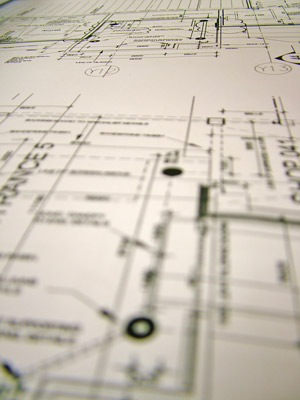 Text by Blair Korchinski
Text by Blair Korchinski
Whether designing a whole house, planning a renovation or addition, or simply moving the furniture around, a floor plan will save you time and money. Choices you make at the beginning of the floor plan process are choices that you will have to live with for a long time, as later changes can be expensive.
The first step is to get some ideas. Look at a variety of magazines, watch the home shows on television, talk to friends and relatives, and tour open houses and show homes. This will help you determine your likes and dislikes and allow you become familiar with common designs.
Once you have some ideas, make a list of your wants and needs. The easiest way to determine these is to ask yourself some questions. Which questions you ask and give priority to will change with the space you are planning. What is the space going to be used for? Is it going to have more than one use? What are your hobbies and pastimes? Do you have children? What are their ages? How long do you plan to stay in the house? Are your wants and needs likely to change over that time? Do you entertain guests a lot? Do you require a home office or work-space? Are there any special requirements due to health concerns or physical disabilities? Are there likely to be such requirements in the future?
More specific spaces will affect what questions you ask and increase the importance of some general questions. If you are planning a kitchen, you will want to take your cooking and eating habits into consideration, as well as your preferences for appliances.
One very important thing to consider is traffic flow through the space you are designing. Entrances should have room to remove shoes and outerwear. The entertainment and conversation areas should not double as the natural pathway through the room. Recreational items such as pool and ping-pong tables should have ample space around them. There should be a clear and relatively short path to the kitchen from the parking area to make carrying groceries easy.
When drawing up a floor plan, it is a good idea to draw out a rough plan to scale on graph paper. This will give you an idea of what the space will look like and determine where high traffic areas are likely to be, where you may require additional lighting and where to place major pieces of furniture.
The easiest way to determine where to place furniture is to cut out several pieces of paper as scale representations of the furniture you have or plan to buy. These pieces can then be moved around. This will allow you to see how furniture will fit into the planned space and assist you both in designing a suitable space and planning furniture purchases.
Whether drawing up the final plans yourself or working with professional architects and designers, identifying your wants and needs and drawing some rough sketches before you begin will help to ensure a more livable home.
Latest posts by Canadian Home Trends (see all)
- Layer Up – Wrap Your Bathroom In Light - January 1, 2026
- The Power of Rest: Elevate Your Wellness with Better Sleep - January 1, 2026
- VERSATILE KITCHEN DESIGN - January 1, 2026






